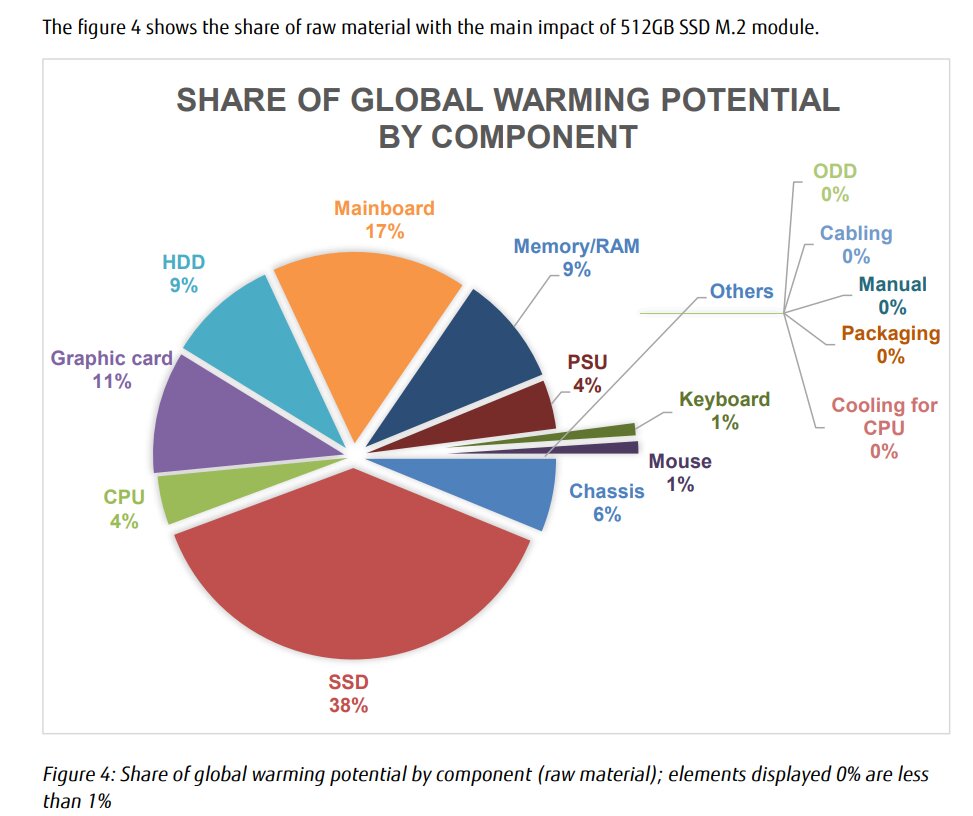Researchers have conducted a study to draw attention to the fact that the production of SSDs produces significantly larger amounts of the greenhouse gas CO2 than other PC components. The cause lies in the large number of built-in chips. However, the advantages of an SSD are neglected in the study.
The “Dark Secret of SSDs”
The study “The Dirty Secret of SSDs: Embodied Carbon” (PDF) by researchers Swamit Tannu from the University of Wisconsin-Madison and Prashant J Nair from the University of British Columbia is intended to show that SSDs, for all their advantages over HDDs, are more suitable for mass storage also offer disadvantages from the point of view of climate protection. Although they require less energy to operate, the production of the memory chips eats up significantly more resources. After all, there are sometimes dozens of chips in an SSD, which are not only divided between the NAND packages, but also the controller and the DRAM cache.

And the production of semiconductor chips requires a lot of energy, which still mainly comes from non-renewable sources. As a result, manufacturing the components of an SSD emits much more CO2 than an HDD. The following graphic comes from an environmental report by Fujitsu (PDF) and breaks down the respective share of the components in the emissions (mainly CO2) caused by a workstation system. There, the SSD is still far ahead of the mainboard, the graphics card or the CPU with 38 percent; the HDD is given 11 percent.
 Percentages of components in the emissions of a workstation (Image: Fujitsu (PDF))
Percentages of components in the emissions of a workstation (Image: Fujitsu (PDF))In a table, the researchers also compare the CO2 generated during operation (OPEX) and production (CAPEX) of an HDD and an SSD, each with a storage volume of 1 TB. In operation, the SSD has a clear advantage thanks to the lower power consumption, but this is reversed during production. If both are added together, the CO2 emissions of the SSD are still almost twice as high as those of the HDD. Over a period of use of 5 years, an HDD including production should cause emissions of 99.6 kg CO2, with an SSD it is 184 kg. Calculated over 10 years, it is 199 kg CO2 for the HDD and 369.2 kg for the SSD.
According to the calculation, over a period of 10 years, the SSD still accounts for 87 percent of the emissions from production and the much smaller remainder from operation. With the HDD it is the other way round, because 80 percent is used for operation and only 20 percent for production.
The storage density of NAND flash is increasing, so fewer chips are required for the same storage capacity. However, the advances in the manufacturing process are accompanied by ever-increasing energy requirements, as another graphic shows. The CO2 emissions in kg per cm² are constantly increasing.
 With advanced manufacturing, energy requirements are increasing (Image: The Dirty Secret of SSDs: Embodied Carbon (PDF))
With advanced manufacturing, energy requirements are increasing (Image: The Dirty Secret of SSDs: Embodied Carbon (PDF))The researchers suggest that when choosing the storage medium, not only the running energy costs but also the resources required for production should be considered. A good approach to more sustainability is also to use the SSDs for as long as possible and to extend their service life, for example through better error correction measures or the return to SLC operation with 1 bit per cell. However, this means a lower storage capacity compared to MLC or today's TLC SSDs with 3 bits per cell.
The study doesn't show the whole picture
What the study neglects, however, is the performance advantage of an SSD. With higher throughput rates but above all a fraction of the latency of an HDD, SSDs complete many tasks significantly faster. In this way, they can switch back to economical idle mode more quickly.
Particularly in data centers, the SSD technology offers immense advantages due to the lower space and energy requirements. SSDs with high storage density and performance can easily replace whole groups of HDDs. As a result, fewer server cabinets are required, which means further savings on the entire infrastructure.
The fact that SSDs have not long since gained the upper hand in the cloud sector is due to the high costs per gigabyte . HDDs will continue to have an advantage here for the foreseeable future. However, their CO2 footprint will probably increase due to increasingly complex methods of increasing storage density.

